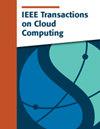PHOENIX: Misconfiguration Detection for AWS Serverless Computing
IF 5
2区 计算机科学
Q1 COMPUTER SCIENCE, INFORMATION SYSTEMS
引用次数: 0
Abstract
Serverless computing is a burgeoning cloud computing paradigm that allows developers to implement applications at the function level, known as serverless applications. Amazon Web Services (AWS), the leading provider in this field, offers Serverless Application Model (AWS SAM), a widely adopted configuration schema for configuring functions and managing resources. However, misconfigurations pose a major challenge during serverless application development, and existing methods are not applicable. To our knowledge, the configuration characteristics and misconfiguration detection for serverless applications have not been well explored. To address this gap, we collect and analyze 733 real-world serverless application configuration files using AWS SAM to understand their characteristics and challenges. Based on the insights, we designPHOENIX:用于AWS无服务器计算的错误配置检测
无服务器计算是一种新兴的云计算范式,它允许开发人员在功能级别实现应用程序,称为无服务器应用程序。该领域的领先提供商Amazon Web Services (AWS)提供无服务器应用程序模型(AWS SAM),这是一种广泛采用的配置模式,用于配置功能和管理资源。然而,在无服务器应用程序开发过程中,错误配置是一个主要的挑战,现有的方法不适用。据我们所知,无服务器应用程序的配置特征和错误配置检测还没有得到很好的研究。为了解决这一差距,我们使用AWS SAM收集并分析了733个实际的无服务器应用程序配置文件,以了解它们的特征和挑战。基于这些见解,我们设计了PHOENIX,一种用于无服务器计算的错误配置检测方法。PHOENIX从配置的统一表示中学习配置模式,并识别偏离这些模式的潜在错误配置。为了评估PHOENIX,我们构建了一个包含35个注入错误配置和70个真实错误配置的数据集,这些错误配置具有确定的原因。结果表明,PHOENIX可以检测到100%的注入错误配置,并识别出97.14%的实际错误配置,明显优于最先进的工具。
本文章由计算机程序翻译,如有差异,请以英文原文为准。
求助全文
约1分钟内获得全文
求助全文
来源期刊

IEEE Transactions on Cloud Computing
Computer Science-Software
CiteScore
9.40
自引率
6.20%
发文量
167
期刊介绍:
The IEEE Transactions on Cloud Computing (TCC) is dedicated to the multidisciplinary field of cloud computing. It is committed to the publication of articles that present innovative research ideas, application results, and case studies in cloud computing, focusing on key technical issues related to theory, algorithms, systems, applications, and performance.
 求助内容:
求助内容: 应助结果提醒方式:
应助结果提醒方式:


